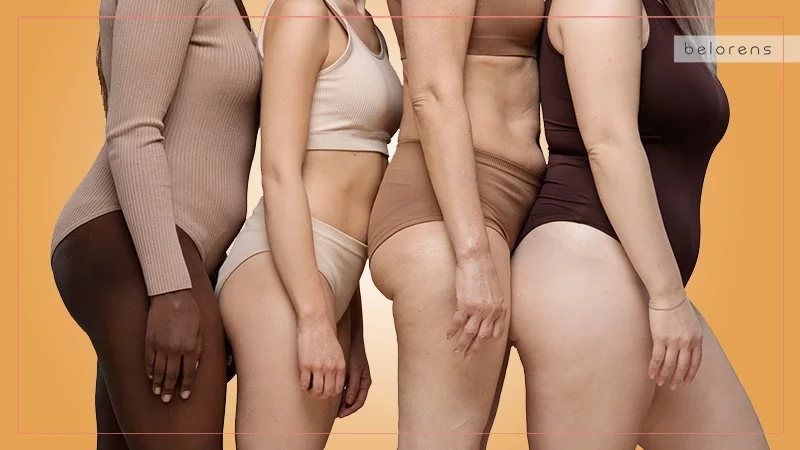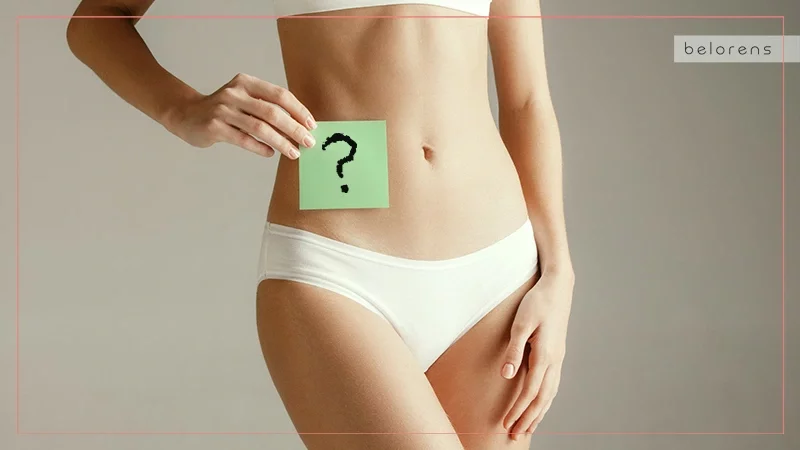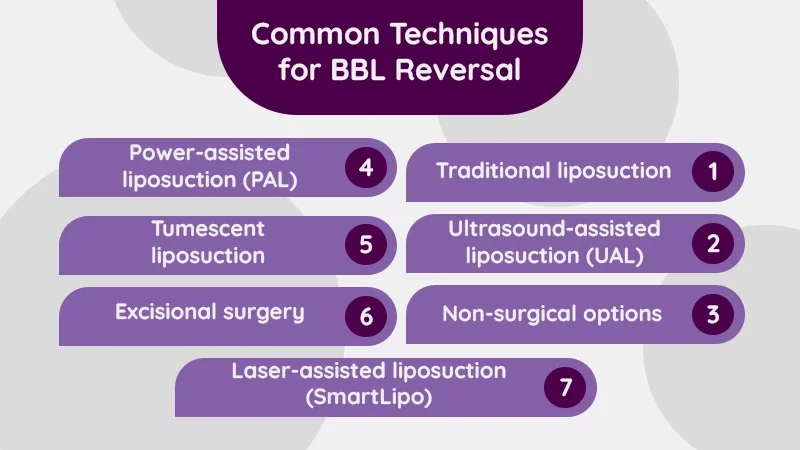
Published on 21 Aug 2024
Undoing the Curve: BBL Reversal and What You Need to Know
Fact checked
In the world of cosmetic enhancements, the Brazilian butt lift (BBL) has become one of the most sought-after procedures, promising fuller and more sculpted curves. However, as with any significant change to one's body, there can come a time when the initial appeal gives way to new desires or unforeseen complications. Whether driven by health concerns, lifestyle changes, or simply a change in aesthetic preferences, the decision to reverse a BBL is not uncommon.
Reversing a BBL is a significant step that requires careful consideration and a thorough understanding of the process involved. It’s not just about reverting to a previous state but navigating a journey that involves medical expertise, personal reflection, and often, emotional resilience. This blog post aims to provide a comprehensive guide to BBL reversal, delving into the reasons one might seek this procedure, the methods available, and the important factors to consider to ensure a safe and successful outcome.
What is a BBL?
The Brazilian butt lift or BBL is a cosmetic procedure that has gained immense popularity for its ability to enhance and reshape the buttocks using the patient's own fat. This two-step process involves liposuction to remove fat from areas such as the abdomen, thighs, or flanks, which is then purified and injected into the buttocks. The result is a fuller, more contoured rear that aligns with the patient's desired aesthetic.
The BBL has become increasingly popular due to its ability to provide significant and natural-looking enhancement without the need for foreign materials. Celebrities and social media influencers have also contributed to its rise in popularity, showcasing their enhanced figures and setting new beauty trends. Their public endorsement, whether intentional or not, played a significant role in the surge of interest in this cosmetic procedure. Kim Kardashian is arguably the most influential figure in popularizing the BBL. Her curvaceous figure has been a subject of fascination and admiration worldwide. Although she has not publicly confirmed undergoing a BBL, her transformation over the years has fueled speculation and inspired many to seek similar enhancements.
Why reverse a BBL?

Aesthetic preferences can change over time. What initially seemed like an enhancement might no longer align with one's evolving sense of self or lifestyle. Some individuals might find their enhanced curves disproportionate or no longer appealing. Additionally, results can sometimes be uneven or not meet the patient's expectations, leading to dissatisfaction and a desire for reversal.
One major reason people seek a BBL reversal—or a butt reduction in case they naturally have too big buttocks—is the influence of celebrities. Famous figures are constantly in the public eye, and their appearances, styles, and bodies become aspirational symbols for many. When a celebrity adopts a particular look, it often garners widespread attention and emulation. For instance, when celebrities like the Kardashians popularized the BBL, it led to a surge in the procedure's popularity.
Platforms like Instagram, TikTok, and Twitter amplify the influence of celebrities by providing a space where their images and lifestyles are continuously broadcasted. Followers often seek to imitate the aesthetics of these figures, leading to rapid and widespread adoption of new trends. For instance, there's been a growing conversation in social media about the supposed end of the Brazilian Butt Lift (BBL) era. This speculation began after photos of Kim and Khloé Kardashian appeared, showing their backsides looking noticeably smaller, sparking rumors that they might have had their BBLs reversed — procedures they never publicly acknowledged having. On TikTok, theories about Kim Kardashian’s alleged “butt reduction” have been rampant, contributing to a spike in Google searches for "Kardashian reverse BBL."
Medical issues are another significant reason for considering a BBL reversal. Some patients experience complications such as infections, fat necrosis (death of fat cells), or other health-related issues that necessitate the removal of the injected fat. These complications can lead to discomfort, pain, or other health risks, prompting the need for reversal.
As individuals age or their lifestyles change, the augmented curves might not be as practical or desirable. Physical activities, sports, or changes in professional life might make maintaining a BBL less feasible or desirable. This shift can lead individuals to seek a more natural or original body contour.
The psychological impact of a BBL can also be significant. Some individuals may experience regret or feel self-conscious about their enhanced appearance. The societal pressure to conform to certain beauty standards can also lead to a desire to revert to a more natural look. This emotional and psychological burden can be a powerful motivator for seeking a buttock reduction to reverse the results of a previous butt augmentation procedure.
Am I a good candidate for BBL reversal?

Determining whether you are a good candidate for BBL reversal involves considering several factors, including your health status, reasons for reversal, and realistic expectations. Here are some key points to help you assess your candidacy:
Medical evaluation
Your overall health is a crucial factor. Candidates should be in good general health and free from conditions that could complicate surgery or recovery. A thorough medical evaluation by a qualified plastic surgeon will help determine if you are physically fit for the procedure. This includes assessing your medical history, current medications, and any underlying health issues.
Reasons for reversal
Understanding your motivations for reversing your Brazilian butt lift is essential. Common reasons include dissatisfaction with the initial results, health complications, lifestyle changes, and psychological factors. If you are experiencing discomfort, pain, or complications such as infections or fat necrosis, you may be a strong candidate for reversal. Similarly, if your aesthetic preferences or lifestyle have changed significantly, and you feel that the augmented curves no longer suit you, a reversal might be appropriate.
Realistic expectations
Having realistic expectations about the outcome of the reversal procedure is important. While BBL reversal can help restore a more natural contour, it may not completely return your body to its pre-surgery state. Discussing your goals and expectations with your surgeon can help you understand what is achievable and ensure that you are mentally and emotionally prepared for the results.
Psychological readiness
The decision to reverse a cosmetic procedure can be emotionally charged. Candidates should be psychologically prepared for the changes and have a supportive network to help them through the process. It’s important to reflect on why you want the reversal and ensure that your decision is well-considered and not influenced by external pressures.
Skin elasticity and patient’s health
Skin elasticity is a major factor in determining whether you are an ideal candidate for butt reduction or BBL reversal. Patients with good skin elasticity may achieve better contouring results post-reversal. However, if the skin has been significantly stretched or the patient has underlying health conditions, the success of the reversal may be compromised.
Consultation with a qualified surgeon
A consultation with a board-certified plastic surgeon is essential to assess your suitability for BBL reversal. The surgeon will evaluate your specific case, discuss the potential risks and benefits, and create a tailored plan that aligns with your goals. This professional guidance is crucial in making an informed decision.
Also Read: Do Breast Implants Affect My Exercise Routine?
How is BBL reversed?

Reversing a Brazilian Butt Lift (BBL) can involve several methods, including various liposuction techniques and non-surgical options. The choice of method depends on the amount of fat to be removed, the patient’s health, and their aesthetic goals. Here are the primary methods used for BBL reversal:
- Traditional liposuction: This is the most common technique for BBL reversal, involving the use of a cannula to suction out fat through small incisions. It allows for the removal of significant amounts of fat and reshaping of the buttocks.
- Ultrasound-assisted liposuction (UAL): This technique uses ultrasound waves to liquefy fat before removal. It’s particularly useful for removing dense or fibrous fat and can result in smoother contours.
- Laser-assisted liposuction (SmartLipo): In this method, laser energy is used to melt the fat, which is then suctioned out. This technique also promotes skin tightening, which can help improve the overall appearance of the buttocks after fat removal.
- Power-assisted liposuction (PAL): This technique employs a vibrating cannula to break up fat cells, making them easier to remove. PAL can be less physically demanding for the surgeon and can improve precision in fat removal.
- Tumescent liposuction: A solution of saline, lidocaine, and epinephrine is injected into the treatment area to numb it, reduce bleeding, and make the fat easier to remove. This method is often used in conjunction with other liposuction techniques to enhance safety and effectiveness.
- Excisional surgery: In cases where liposuction alone is insufficient, excisional surgery may be required. This involves making larger incisions to directly remove fat tissue and potentially excess skin. It’s a more invasive procedure and is typically reserved for cases where a significant volume of fat needs to be removed.
- Non-surgical options: While less common and generally less effective than surgical methods, non-surgical options for BBL reversal include treatments like radiofrequency-assisted lipolysis (RFAL) and cryolipolysis (CoolSculpting). These methods use heat or cold to break down fat cells, which are then naturally eliminated by the body. Non-surgical options are typically better suited for minor adjustments rather than complete reversals.
Each of these methods has its advantages and limitations, and the best approach depends on individual circumstances and goals. Consulting with a qualified plastic surgeon is essential to determine the most appropriate method for reversing a BBL, ensuring safety and satisfactory results.
Also Read: Lipo 360: Everything About Full-Body Liposuction
Is reversing a BBL easy?
Reversing a Brazilian butt lift depends on several factors, including the location of the injected fat. When fat is injected above the muscle, in the subcutaneous layer, it is generally easier to remove. Liposuction techniques can effectively target and remove fat from this layer, allowing for a more successful reversal. This method of injection is also considered safer because it avoids the deeper muscle layers and associated blood vessels, reducing the risk of serious complications.
If the fat was injected under the muscle, in the intramuscular layer, reversing the BBL becomes significantly more challenging. Removing fat from within the muscle is more complex and poses higher risks. This method of fat injection can lead to a more natural and aesthetic look, but it complicates any future attempts at fat removal. Surgeons are less likely to perform liposuction in this area due to the risk of damaging muscle tissue and blood vessels.
Additionally, injected fat cells integrate with the existing tissues over time. This integration can make it more difficult to remove the fat completely, especially if significant time has passed since the original procedure. The longer the fat has been in place, the more challenging it can be to achieve a full reversal.




